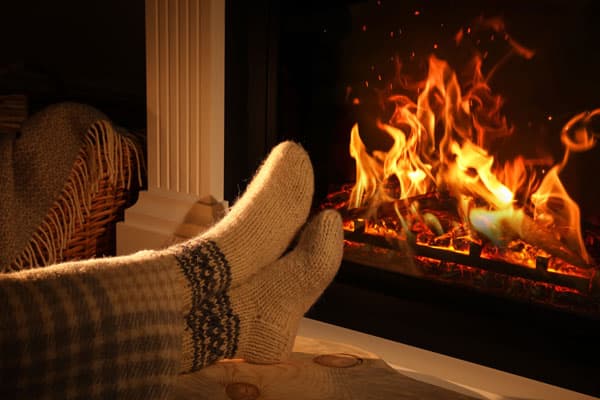
How Long Can You Run a Gas Log Fireplace?
If your home has a gas fireplace or you’ve just purchased and moved into one that has one, you might be wondering what safety guidelines you should follow when using it. There’s the imagery of sitting by a roaring fire all day long as it snows outside, but as a homeowner you might question this idyllic scene because after all, you don’t exactly want to start a chimney fire.
So, what’s the verdict? Can you leave a gas fireplace on all day like a Norman Rockwell painting or is that just dreaming big?
In short, you really shouldn’t let a gas fireplace on for too long—specifically more than three hours at a time. But there are multiple types of gas fireplaces, so it does depend on which type your home has.

Types of Gas Fireplaces
Residential homes typically will have three types of gas fireplaces: gas fireplace inserts, direct vent fireplaces, or vent-free fireplaces. It’s important to know that not all of these types of gas fireplaces can operate continuously, but some can, which is why it’s critical to know their differences and how they operate.
Gas Fireplace Inserts
Inserts are extremely common because they’re the type of fireplace that can be installed within an already existing traditional masonry fireplace area. Inserts vent with a pipe that’s installed within the existing chimney, which releases the combustion byproducts, toxins, and fumes outside.
These inserts can operate continuously without fear of chimney fires or the like, so long as the front of the insert is completely sealed. This prevents fumes from leaking out into the living space, and that’s something that’s regulated upon installation (although it doesn’t hurt to check yourself every now and then).
Direct Vent Fireplaces
What makes a direct vent gas fireplace different is its exhaust vent. Its exhaust vent is installed directly into an exterior wall. This means you can have a direct vent fireplace without having an already existing masonry fireplace as well as a chimney.
Skirting the traditional fireplace and venting directly to the outside can save a homeowner a huge headache in trying to figure out how to have a fireplace if their home wasn’t already equipped one. There’s no need to build a chimney in order to have a roaring fire with a direct vent fireplace.
Because the direct vent does just that—vent dangerous fumes and byproducts to the outside—you can run this style of fireplace continuously. Like the gas fireplace inserts, you’ll want to make sure the front glass is sealed completely. This would be the only place where fumes could possibly leak out into a living space, but you can run the fireplace for as long as you want if its front is sealed as it should be.

Vent-Free Fireplaces
Like its name suggest, vent-free fireplaces don’t vent exhaust fumes to the outside. Vent-free fireplace styles have gotten a lot of eyebrow raises because they don’t vent these combustion byproducts, but they’ve proven to be safe due to strict manufacturer regulations.
Because of its design, it’s not recommended that you use this vent-free fireplace style for more than a few hours at a time. Referring to the manufacturer’s handbook for your vent-free fireplace, you’ll also see that running this style of fireplace for just a few hours is recommended.
Gas Fireplaces and Safety
An overall rule for safe gas fireplace usage is to not let your fireplace—no matter which style—operate throughout the night. Unmonitored gas fireplaces can lead to dangerous, often fatal, outcomes.
The two most concerning outcomes of leaving a gas fireplace on for too long are a house fire or a gas leak. Leakage from a gas fireplace means toxic fumes and combustion byproducts that aren’t good for humans or animals.
Carbon monoxide can have fatal consequences and goes undetected if your home isn’t equipped with proper detector. Not only does this emphasize the need for carbon monoxide and smoke detectors, but it should also serve as a warning that gas fireplaces should be monitored carefully.
Accidental fires can also occur should you leave an unvented or improperly sealed gas fireplace running for too long—and without watching it. Chimney fires are common occurrences for unmaintained and unwatched fireplace.
The Bottom Line
The short answer is this: gas fireplaces that are fully vented and have safely and properly sealed glass fronts are fine to be left alone to run continuously. And the bottom line? Even if your gas fireplace is sealed and vented to release fumes into the outside, it’s better to lean towards the safer side of things and only leave it running for two to three hours at a time. When in doubt, consult the manufacturer of your gas fireplace.
From replacing fireplace dampers to sweeping chimneys, Vertical Chimney Care has been Chicagoland's go to choice since 1985. We dedicate our services to keeping your home cleaner and safer.
